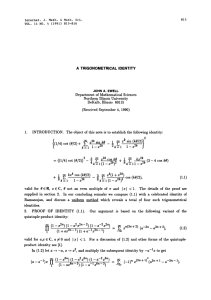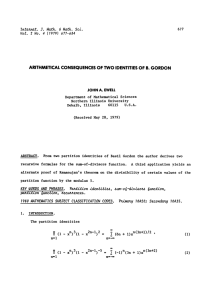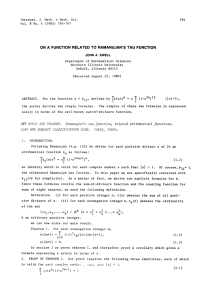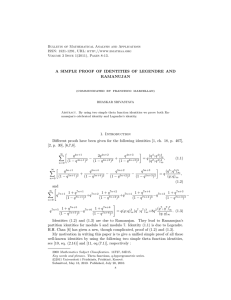Document 10471181
advertisement
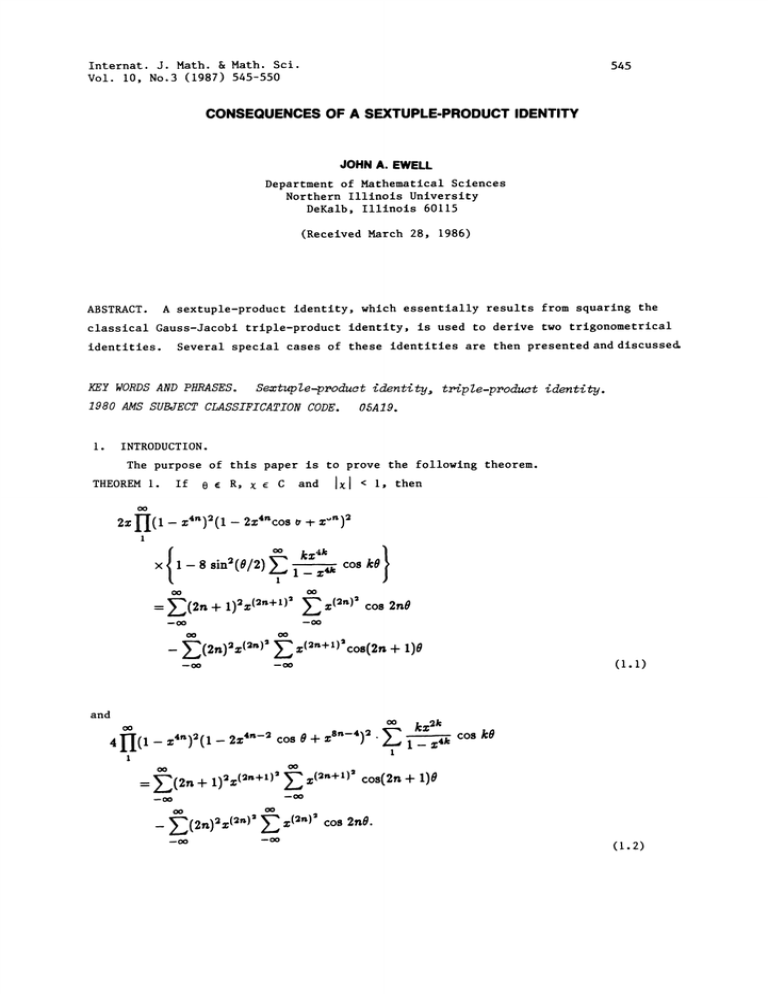
Internat. J. Math. & Math. Sci. Vol. i0, No.3 (1987) 545-550 545 CONSEQUENCES OF A SEXTUPLE-PRODUCT IDENTITY JOHN A. EWELL Department of Mathematical Sciences Northern Illinois University DeKalb, Illinois 60115 (Received March 28, 1986) ABSTRACT. A sextuple-product identity, which essentially results from squaring the classical Gauss-Jacobi triple-product identity, is used to derive two trigonometrical identities. Several special cases of these identities are then presented anddiscusseg KEY WORDS AND PHRASES. Sextuple-product identity, triple-product identity. Ig80 AMS SUBJECT CLASSIFICATION CODE. 05A19. INTRODUCTION. 1. The purpose of this paper is to prove the following theorem. THEOREM I. If 0 R, X C and IX < I, then (1.1) and 4 H(1 z4")(1- 2z4"-’ cos 0 + z’"-4) ’’ cos kO (1.2) 546 J.A. EWELL The details of the proof are supplied in Section 2 where the major tool is the identity (1.3) valid for complex numbers =, x such that zl # 0 and < I. In the papers [I] and [2] the author derives this identity in two different ways from the classical Gauss-Jacobi triple-product identity wih he same restrictions on and z. For the firs of hese derivations a sub- stantlal assist by Gauss [3, pp. 78-79] is acknowledged. We shall also require the following identities (il4)cotCOl2) + (1/4)cot(el2) 8 (1- z")= + / z(1 1 (l+z) kz (In (1.5) I- z -cos kz (1.6) is assumed to not be an even multiple of .) Ramanujan [4,p. 139]. (1.5) Identity (1.5) is due to However, in [5] the author deduces both of these results from the triple-product identity (1.4). In Section 3 a few special cases of (I.I) and (I. are noted. 2. PROOF OF THEOREM I. z To prove (I.I) we first of all, let the resulting identity by --00 z -z2 z2, in (1.3), and multiply to get O0 Now, for an arbitrary complex variable noting derivation with respect to --00 --00 z regard Zz Then, letting as an operator, F(a,x} DZ de- denote the left side CONSEQUENCES OF A SEXTUPLE-PRODUCT IDENTITY of (2.1), and putting (x) := .x (2n)2, (x) := x (2n+I)2 547 (for both sums summation Z), we have extending over while Hence, , , (D.)FC z) CzD)FC z) (2.2) --00 For Z+ k and z c, Itl - < i, put u k uklt) := t(1-) -I Then by straight- forward logarithmic differentiation, we get: , We now put -4 :=i8 ()( -) and realize that (2.2) becomes: sin(O/2)x (a- x4")(a- 2x4cos # + xs) z cos(2n + I)0 } -4 (1o0 + (1 + (1[(1 + lo o ]-I By Ramanujan’s identity (1.5) the foregoing identity then reduces to identity (i.i). -a, To prove (1.2) we begin by transforming (1.3) under the substitutions a J.A. EWELL 548 X X The remaining details are similar to the ones for the proof of (I.I), but in the final simplification identity (1.6) plays the same role as did identity (1.5) in the foregoing derivation. 3. SPECIAL CASES OF IDENTITIES (I. I), (1.2). For each complex number X such that Xl COROLLARY 2. < I, (3.1) (3.2) PROOF. letting X To prove (3.1) we appeal to (I.I), putting }. COROLLARY 3. To prove (3.2) put 8 0 For each complex number in (1.2). x such that O, dividing by 2 8 II and < I, zsy I (3,3) 4 PROOF. H(I z’Sn):(l + zsn-") : C-I)Y2]z’Y 1 " (3.4) In (L.l)and(2,1)put w/2 to respectively obtain (3.3) and (3.4). < I, For each complex number such that KI COROLLARY 4. (3.6) PROOF. Put in (l.l)and(:!.. to respectively obtain (3,) and (3.6). REMARK. CONSEQUENCES OF A SEXTUPLE-PRODUCT IDENTITY 549 Of the six identities in the foregoing corollarles(’3.1$’has been by far the For example in [i] the author has used the identity to prove Ramanujan% theorem on the divisibility of certain values of the partition function by the modulus 7. The identity was also used by the author in [6] to establish Jacobi’s formula for most fruitful. the number of representations of a natural number by sums of four squares. However, the remaining identities certainly have some intrinsic interest, since each of them combines in a single expression infinite products, ordinary power series and "Lambert" series. REFERENCES Completion of a Gausslan Derivation, Proc. Amer. Math. Soc. 84(1982), 311-314. I. EWELL, J.A. 2. EWELL, J.A. 3. MACMAHON, P.A. 4. RAMANUJAN, S. C_ollectd epers, Chelsea, New York, 1962. EWELL, J.A. Consequences of the Triple- and Qulntuple-product Identities, Houston J. of Math. (to appear) EWELL, J.A. A Simple Derivation of Jacobi’s Four-square Formula, Proc. Amer. Math. Soc. 85(1982), 323-326. 5. 6. Some Combinatorial Identities and Arithmetical Applications, Rocky Mountain J. of Math. 15(2) (1985), 365-370. Comblnatory.nalysis, vol. 2, Chelsea, New York, 1960.
